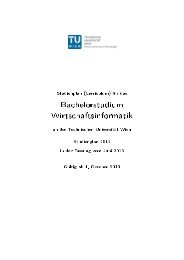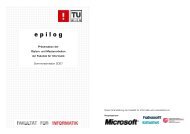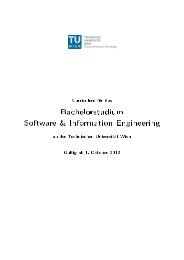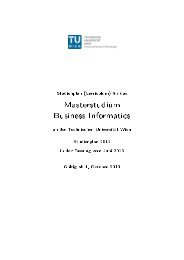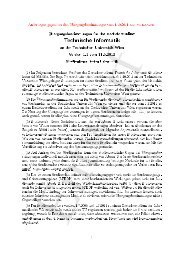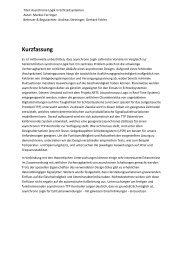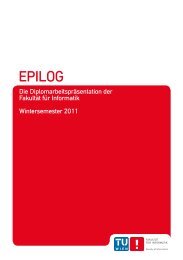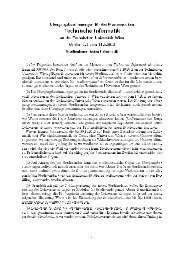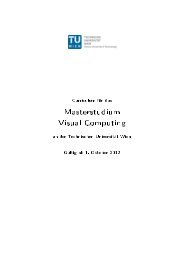Abstract-Band - Fakultät für Informatik, TU Wien - Technische ...
Abstract-Band - Fakultät für Informatik, TU Wien - Technische ...
Abstract-Band - Fakultät für Informatik, TU Wien - Technische ...
Sie wollen auch ein ePaper? Erhöhen Sie die Reichweite Ihrer Titel.
YUMPU macht aus Druck-PDFs automatisch weboptimierte ePaper, die Google liebt.
Einführung dieser Modelle in gewachsenen Strukturen und bei der Migration<br />
von Altsystemen vielschichtigen Problematiken. Mit diesen Fragen und dem<br />
Versuch der Beantwortung auf Basis von Praxisbeispielen setzt sich diese<br />
Diplomarbeit auseinander. Im Rahmen der theoretischen State of the Art-<br />
Grundlagenarbeit werden Methoden und Vorgehensmodelle <strong>für</strong> Softwareprojektmanagement,<br />
Qualitätsmanagement und Qualitätssicherung sowie die<br />
Kernprozesse der Service-Inbetriebnahme und das Change- und Releasemanagement<br />
aus dem De-facto-Standard ITIL dargelegt. Die organisatorische<br />
und prozessuale Anpassungsfähigkeit, besonders im Release- und Changemanagement,<br />
ist dabei ein wichtiger Bestandteil. Im Rahmen der vorliegenden<br />
Arbeit werden Effektivität und Effizienz aus in der Fachliteratur beschriebenen<br />
Vorgehensmodellen in einen Praxisbezug im Projekt- und Programmmanagement<br />
gebracht und die Alltagstauglichkeit anhand praktischer Beispiele aus<br />
dem Projektalltag aufgezeigt. Dabei werden Qualitäts- und Release-prozesse<br />
aus dem Theorieteil in der Praxis verwendeten Prozessen gegen-über-gestellt<br />
und Erweiterungen erarbeitet. Im Rahmen der vorliegenden Arbeit wurden<br />
diese Ansätze <strong>für</strong> Release- und Qualitätsmanagement in Projekten im<br />
Migrationsumfeld von Altsystemen beleuchtet und daraus ein erkennbarer<br />
Regelbetrieb <strong>für</strong> eine leane Planung und eine Planung bei maximal möglichem<br />
Ressourcenstand abgeleitet.<br />
Bernhard Miller<br />
iHoneyClient - Discovery and Analysis of Malware for Mac OS X<br />
Studium: Masterstudium Software Engineering & Internet Computing<br />
BetreuerIn: Ao.Univ.Prof. Dr. Wolfgang Kastner<br />
Over the last few years, Apples operating system OS X has steadily increased its<br />
user base. Today, an estimated 7.5% of all computers worldwide are running<br />
OS X. One reason for this advancement is the platforms questionable reputation<br />
of being inherently safe. However, the growing popularity of Apple<br />
computers has called criminals to attention. An increasing number of malware<br />
families is specifically targeting OS X. While there is a substantial body of research<br />
and tools dealing with malware on Windows and, more recently,<br />
Android systems, OS X has received little attention from security researchers so<br />
far. To amend this shortcoming, I implemented iHoneyClient, a tool to discover<br />
and analyze Mac malware. iHoneyClient offers a high-interaction client honeypot<br />
based on OS X that simulates an end user browsing the web on an Apple<br />
computer. The honeypot is able to examine the threat a website poses to OS X<br />
users. In addition, I built a dynamic analysis sandbox based on iHoneyClient.<br />
With this sandbox it is possible to execute Mac malware samples in an isolated<br />
environment and monitor their behavior. I used iHoneyClient to evaluate over<br />
6,000 blacklisted URLs to estimate how widespread malware for OS X is today.<br />
Furthermore, I used the dynamic analysis environment to analyze 174 malware<br />
samples. The combined results give an overview of the current state of OS X<br />
malware. While several advanced malware families for OS X exist, it is highly<br />
unlikely to become infected by simply browsing the web.<br />
15



